
Segesta was one of the major cities of the Elymians, one of the three indigenous peoples of Sicily. The other major cities of the Elymians were Eryx and Entella. It is located in the northwestern part of Sicily in Italy, near the modern commune of Calatafimi-Segesta in the province of Trapani. The hellenization of Segesta happened very early and had a profound effect on its people.
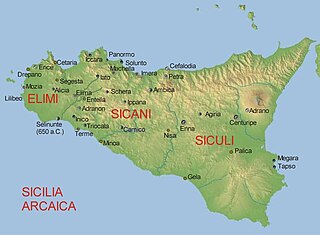
Éntella, was an ancient city in the interior of Sicily, situated on the left bank of the river Hypsas, and nearly midway between the two seas, being about 40 km from the mouth of the Hypsas, and much about the same distance from the north coast of the island, at the Gulf of Castellamare.

Caronia is a town and comune on the north coast of Sicily, in the province of Messina, about half way between Tyndaris and Cephaloedium. The town has 3,555 inhabitants.

Enna, known from the Middle Ages until 1926 as Castrogiovanni, is a city and comune located roughly at the center of Sicily, southern Italy, in the province of Enna, towering above the surrounding countryside. It has earned the nicknames belvedere and ombelico ("navel") of Sicily.
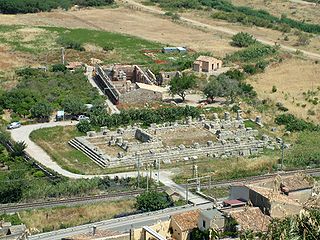
Himera, was a large and important ancient Greek city situated on the north coast of Sicily at the mouth of the river of the same name, between Panormus and Cephaloedium in the comune of Termini Imerese.

Licata, formerly also Alicata, is a city and comune located on the south coast of Sicily, at the mouth of the Salso River, about midway between Agrigento and Gela. It is a major seaport developed at the turn of the twentieth century, shipping sulphur, the refining of which has made Licata the largest European exporting centre, and asphalt, and at times shipping cheese.
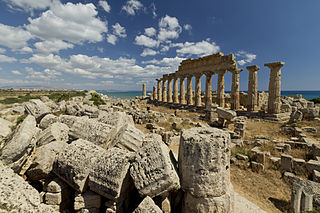
Assorus or Assoros, or Asserus or Asseros (Ἄσσηρος), also known as Assorium or Assorion (Ἀσσώριον), was a city of the interior of ancient Sicily, situated about half way between Agyrium and Enna. It was a city of the Siculi, and appears never to have received a Greek colony. In 396 BCE it is mentioned by Diodorus as the only Siculian town which remained faithful to Dionysius of Syracuse, at the time of the great Carthaginian expedition under Himilco. In consequence, we find Dionysius, after the defeat of the Carthaginians, concluding a treaty of alliance with the Assorini, and leaving them in possession of their independence. At this time it would seem to have been a place of some importance; but no subsequent mention of it occurs in ancient writers until the days of Cicero, in whose time it appears to have been but a small town, though retaining its municipal independence, and possessing a territory fertile in corn. It suffered severely, in common with the neighbouring towns, from the exactions of Verres. We learn from Pliny the Elder and Ptolemy, that it continued to exist under the Roman Empire. and the modern town of Assoro undoubtedly occupies the site, as well as retains, with little alteration, the name of Assorus.

Morgantina is an archaeological site in east central Sicily, southern Italy. It is sixty kilometres from the coast of the Ionian Sea, in the province of Enna. The closest modern town is Aidone, two kilometres southwest of the site. The site consists of a two-kilometre-long ridge running southwest-northeast, known as Serra Orlando, and a neighbouring hill at the northeast called Cittadella. Morgantina was inhabited in several periods. The earliest major settlement was made at Cittadella and lasted from about 1000/900 to about 450 BCE. The other major settlement was located on Serra Orlando, and existed from about 450 BCE to about 50 CE in Magna Graecia. Morgantina has been the subject of archaeological investigation since the early 20th century.

Halaesa, also known as Halaesa Archonidea and also spelled Alaesa or Halesa was an ancient city of Magna Graecia in Sicily, situated near the north coast of the island, between Cephaloedium and Calacte.
San Giuseppe Jato is a village in the Metropolitan City of Palermo in Sicily, southern Italy.

Heraclea Minoa was an ancient Greek city of Magna Graecia situated on the southern coast of Sicily near the mouth of the river Halycus, 25 km west of Agrigentum. It is located near the modern town of the same name in the comune Cattolica Eraclea in Italy.

Aetna, was an ancient city of Magna Graecia in Sicily, situated at the foot of the mountain of the same name, on its southern declivity. It was originally a Sicelian city, and was called Inessa or Inessum.
Agathyrnum or Agathyrna, was an ancient city of Magna Graecia on the north coast of Sicily between Tyndaris and Calacte. It was supposed to have derived its name from Agathyrnus, a son of Aeolus, who is said to have founded the city. But though it may be inferred from this story that it was an ancient city, and probably of Spartan origin, we find no mention of it in history until after Sicily became a Roman province. During the Second Punic War it became the headquarters of a band of robbers and freebooters, who extended their ravages over the neighboring country, but were reduced by the consul Laevinus in 210 BCE, who transported 4000 of them to Rhegium. It very probably was deprived on this occasion of the municipal rights conceded to most of the Sicilian towns, which may account for our finding no notice of it in Cicero, though it is mentioned by Strabo among the few cities still subsisting on the north coast of Sicily, as well as afterwards by Pliny, Ptolemy and the Itineraries.
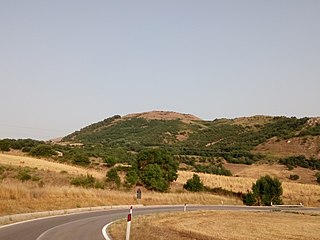
Hippana or Hyppana, was an ancient town of Sicily. It sat astride the main road from Panormus to Agrigentum upon Monte dei Cavalli, in the modern comune of Prizzi. It is an important archaeological site in situated in a central position between the Tyrrhenian coast and the Mediterranean Sea, halfway between Palermo and Agrigentum.

Eryx was an ancient city and a mountain of Magna Graecia in the west of Sicily, about 10 km from Drepana, and 3 km from the sea-coast. It was located at the site of modern Erice.
Mytistraton or Mytistratus or Myttistraton, was an ancient town in the interior of Sicily, the site of which is located at modern the località of Monte Castellazzo di Marianopoli, in the comune of Marianopoli, in the Province of Caltanissetta.
Hybla Gereatis, was an ancient city of Magna Graecia in Sicily, located on the southern slope of Mount Etna, not far from the river Symaethus, in the modern comune of Paternò. There were at least three cities named "Hybla" in ancient accounts of Sicily which are often confounded with each other, and which it is sometimes very difficult to distinguish.

Helorus, Heloros, Helorum, or Elorus, was an ancient Greek city of Magna Graecia in Sicily, situated near the east coast, about 40 km south of Syracuse and on the banks of the river of the same name. It is currently an archaeological site in the modern comune of Noto.
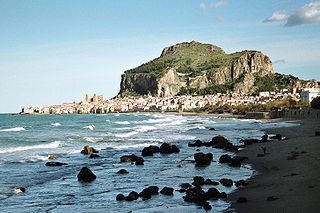
Cefalù, classically known as Cephaloedium, is a city and comune in the Italian Metropolitan City of Palermo, located on the Tyrrhenian coast of Sicily about 70 km (43 mi) east of the provincial capital and 185 km (115 mi) west of Messina. The town, with its population of just under 14,000, is one of the major tourist attractions in the region. Despite its size, every year it attracts millions of tourists from all parts of Sicily, and also from all over Italy and Europe. It is one of I Borghi più belli d'Italia.

Akrai was a Greek colony of Magna Graecia founded in Sicily by the Syracusans in 663 BC. It was located near the modern Palazzolo Acreide.



















